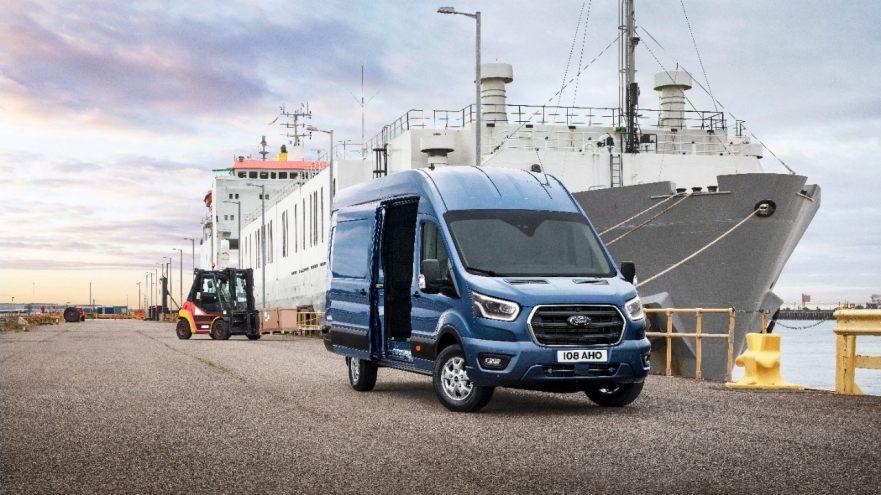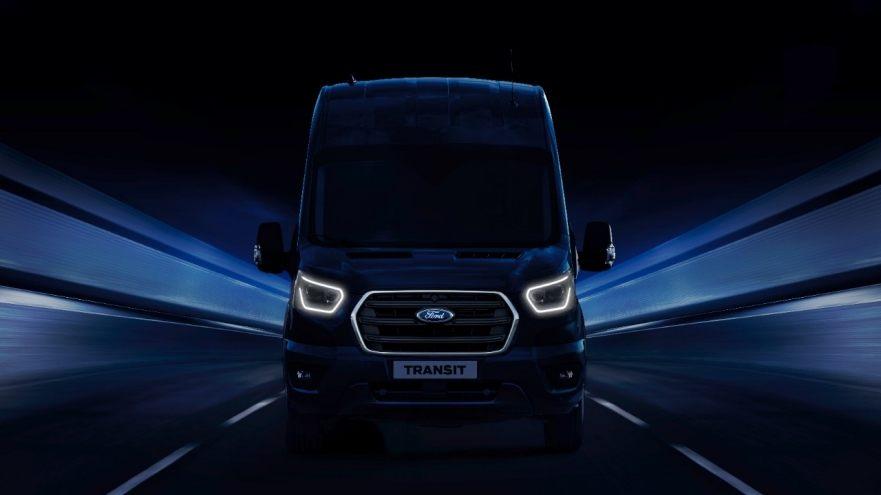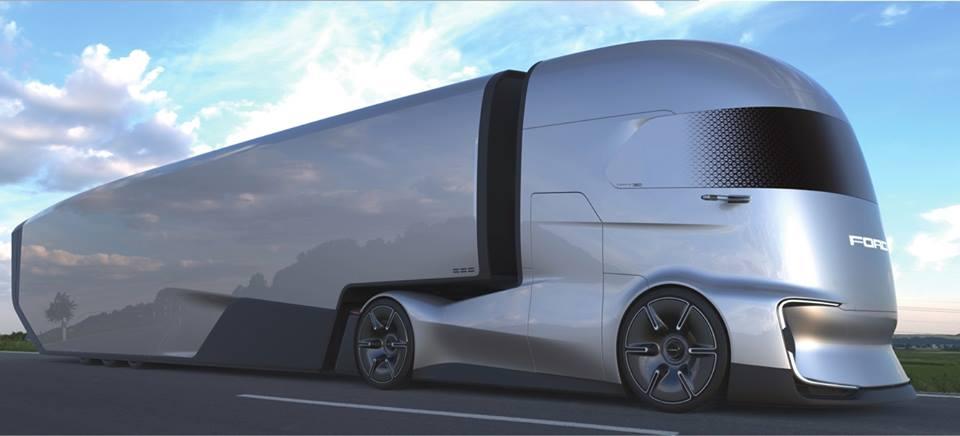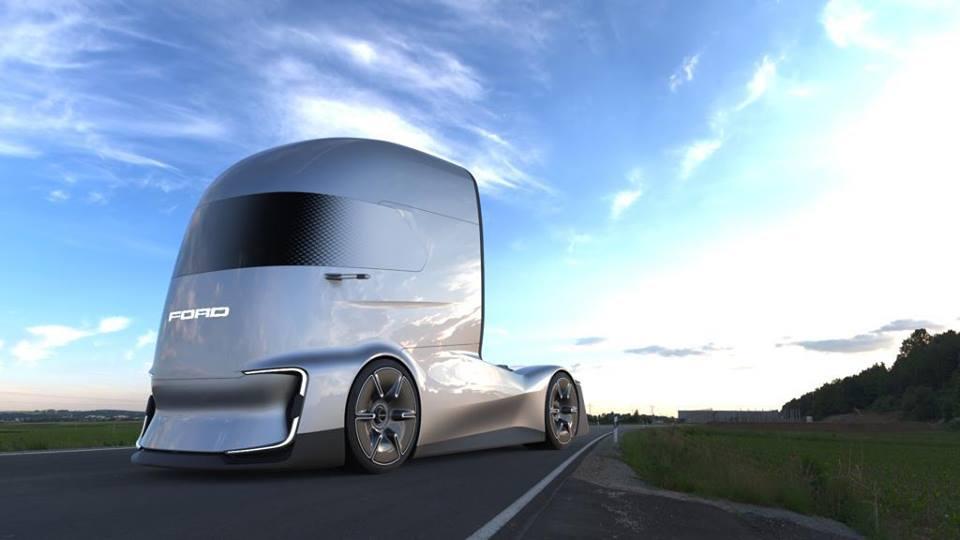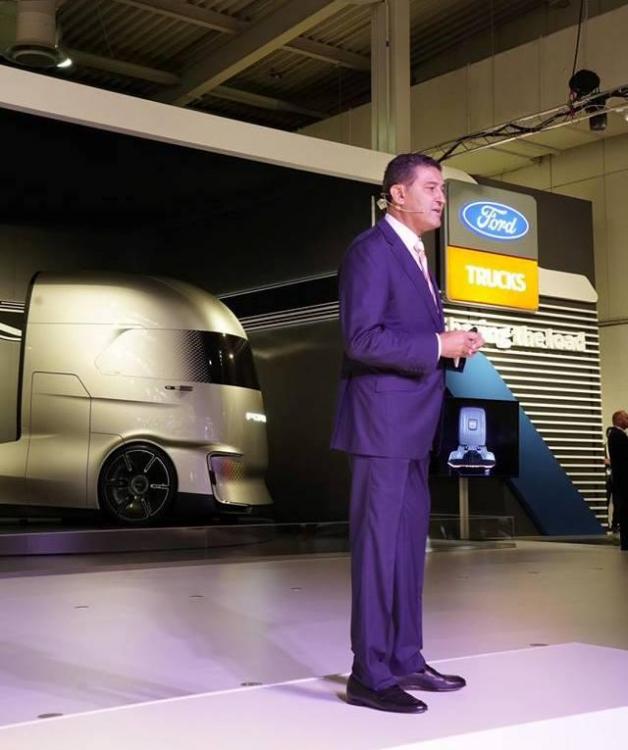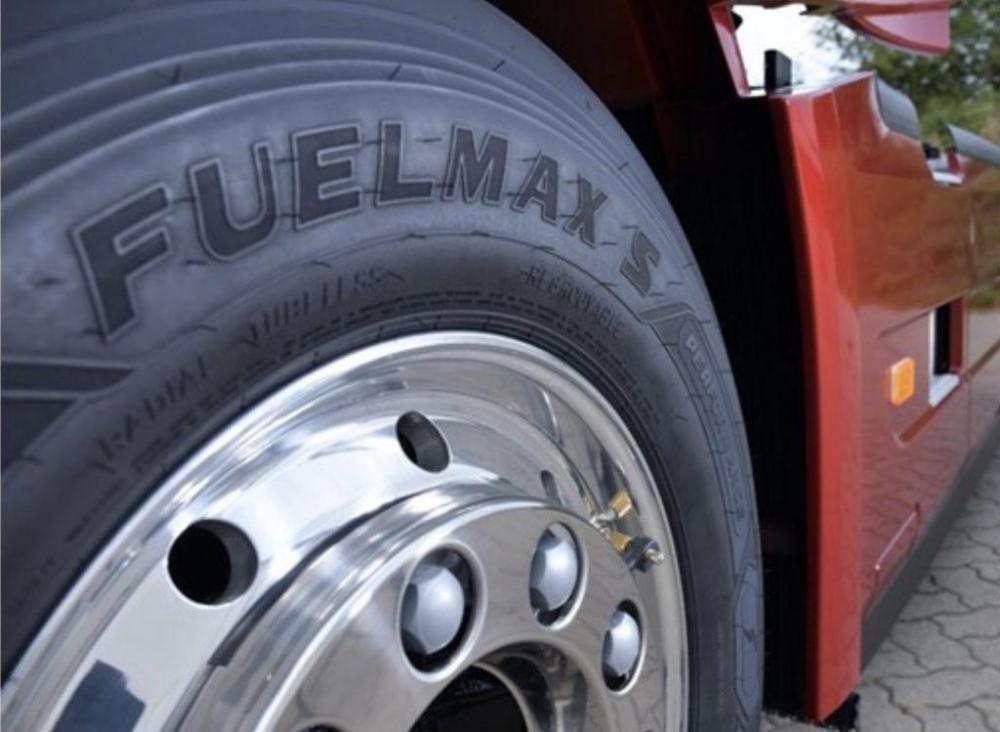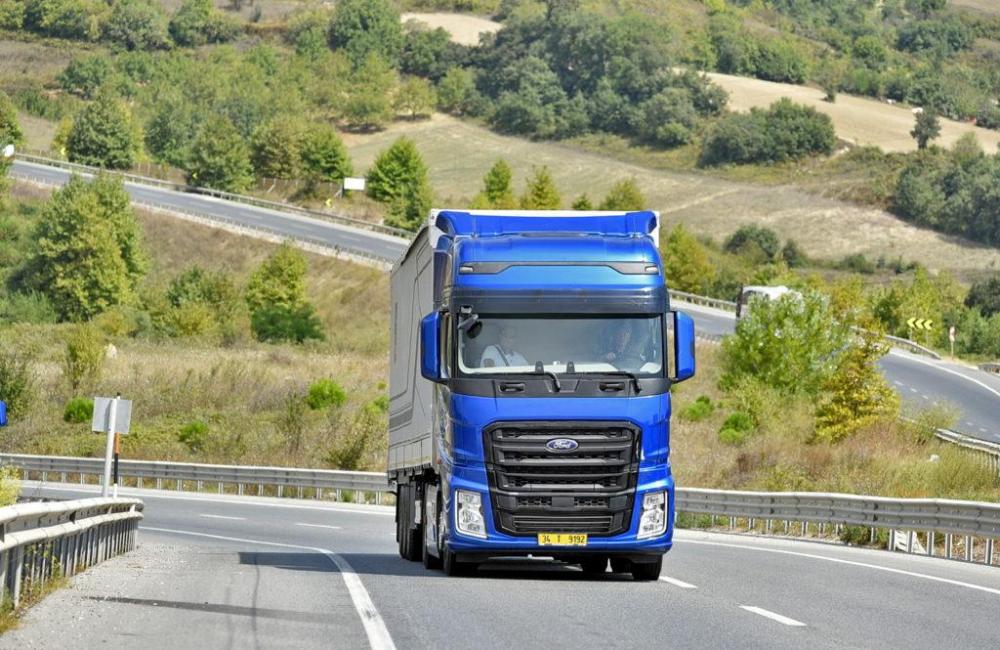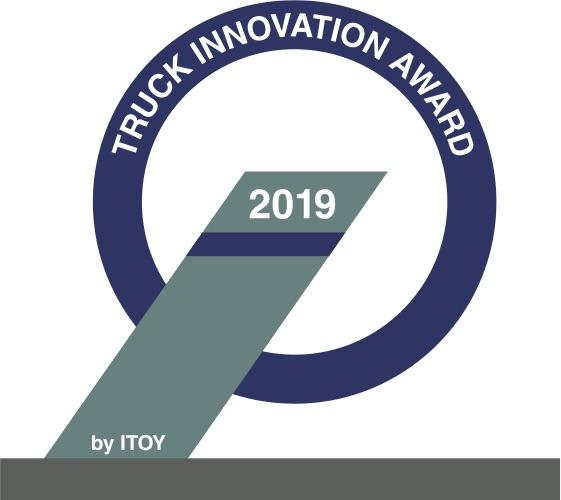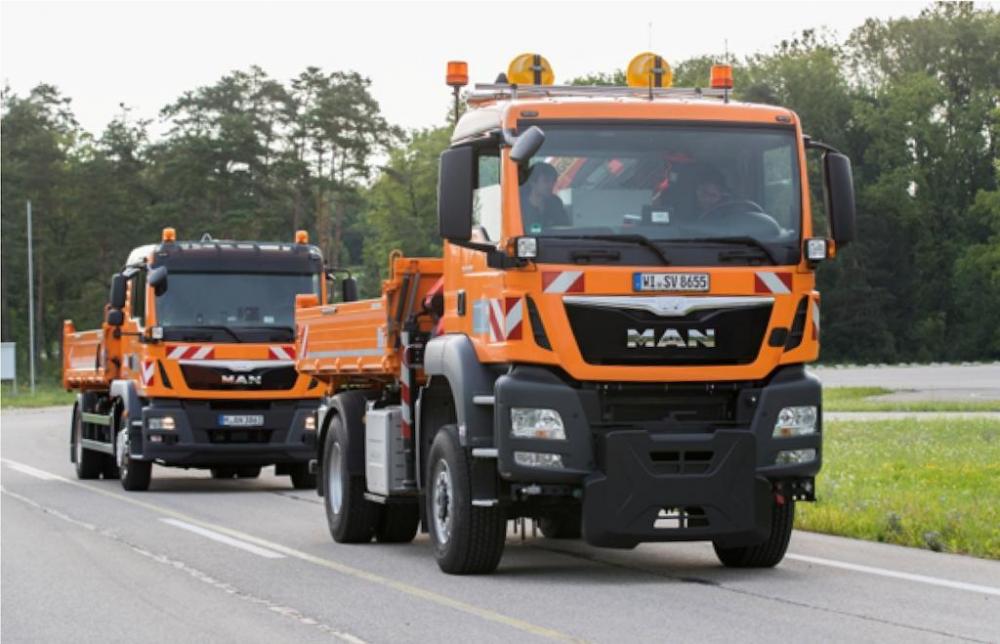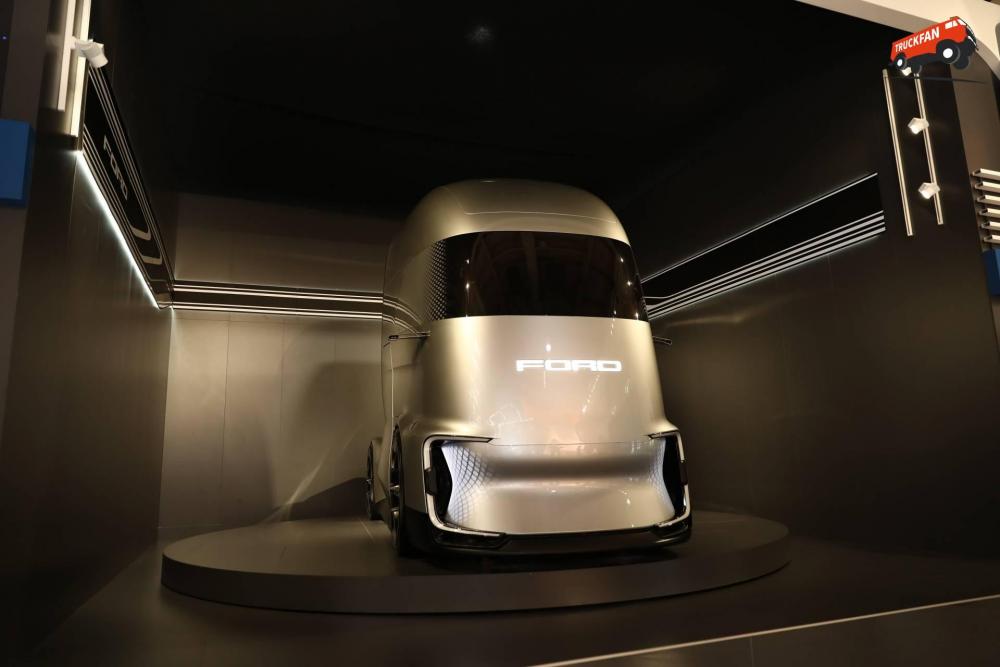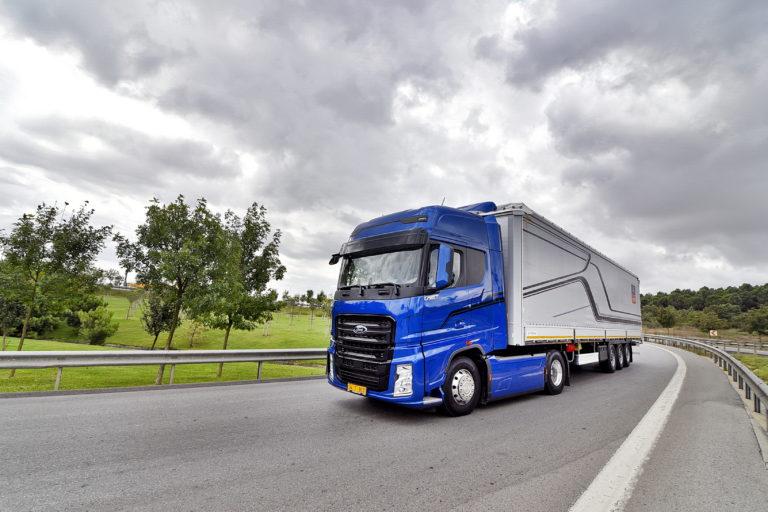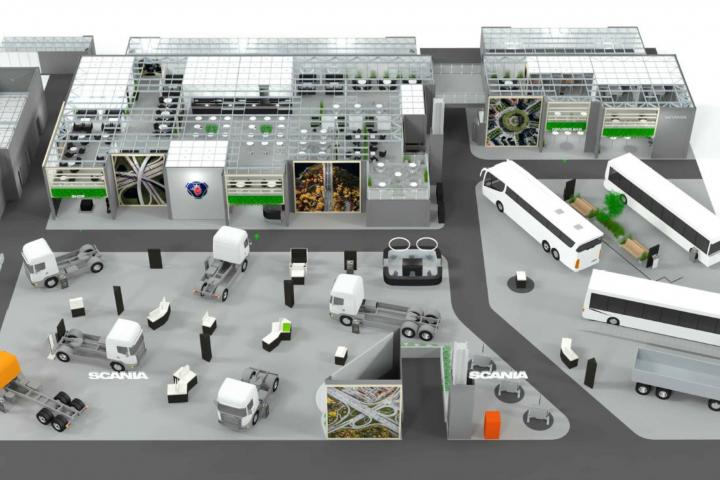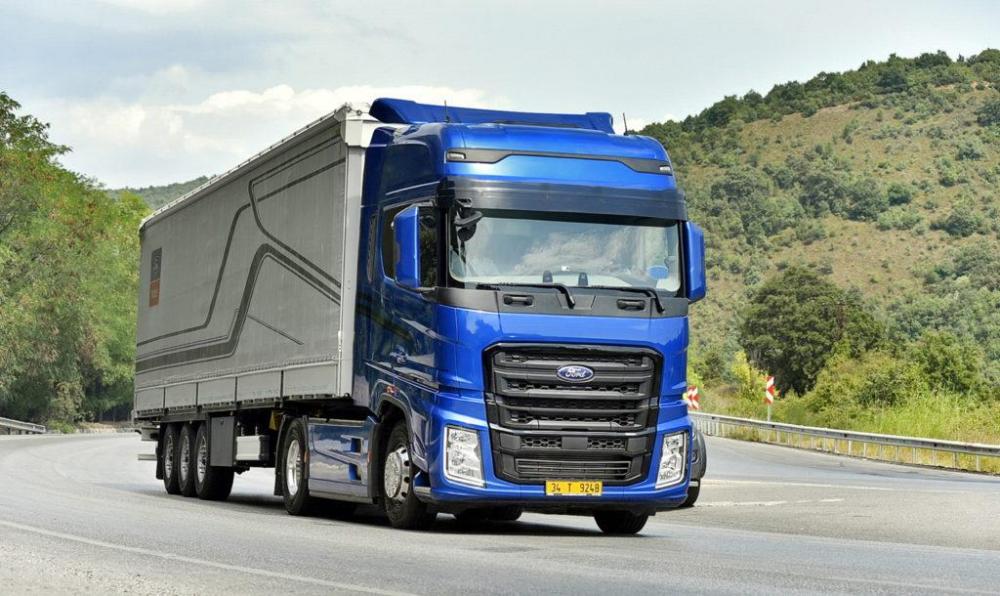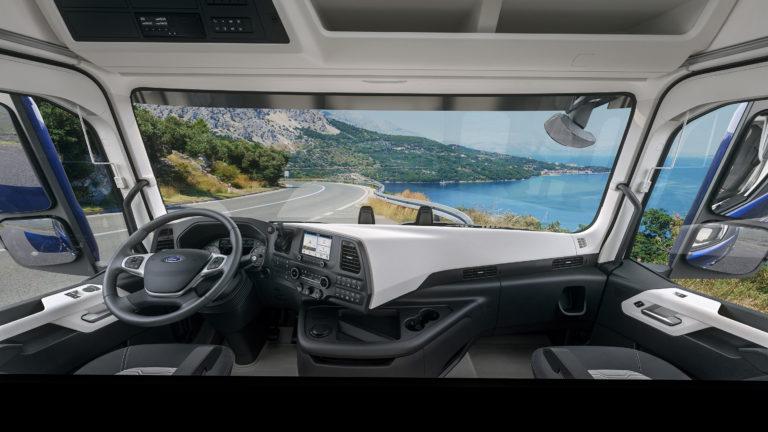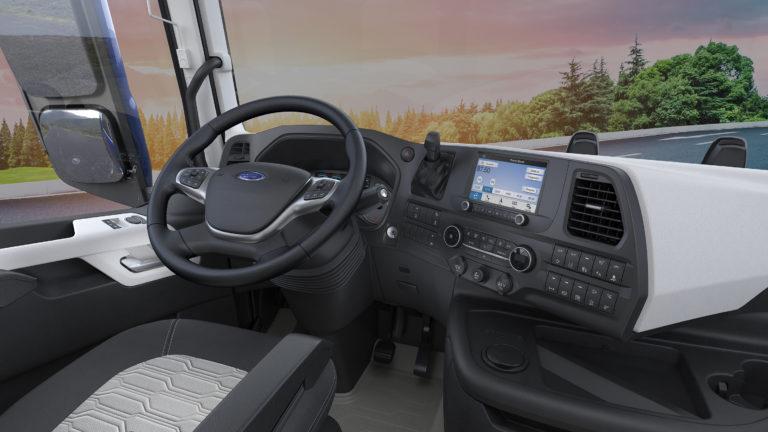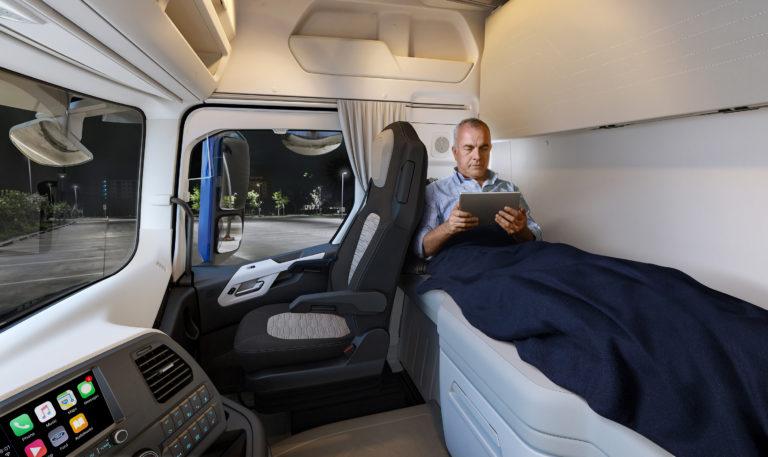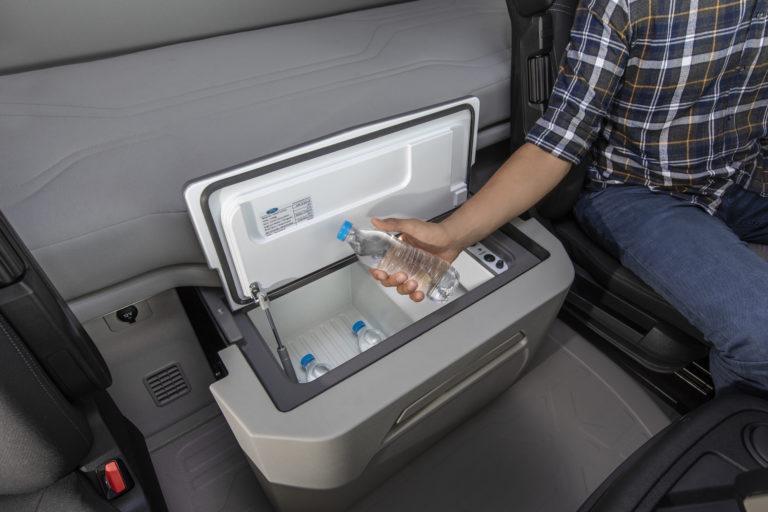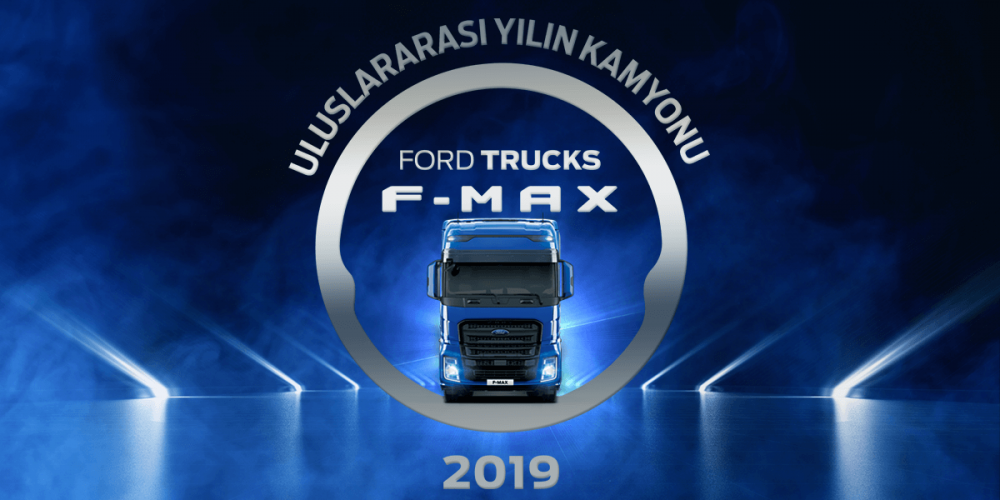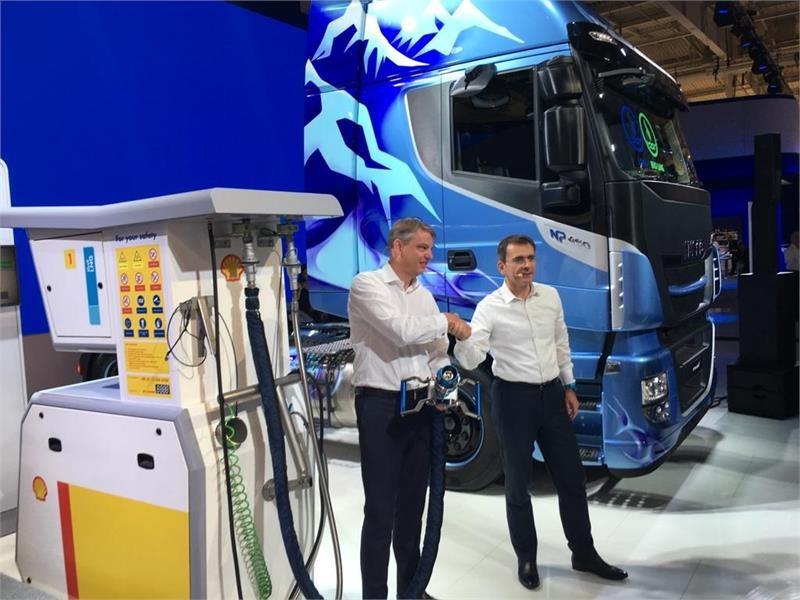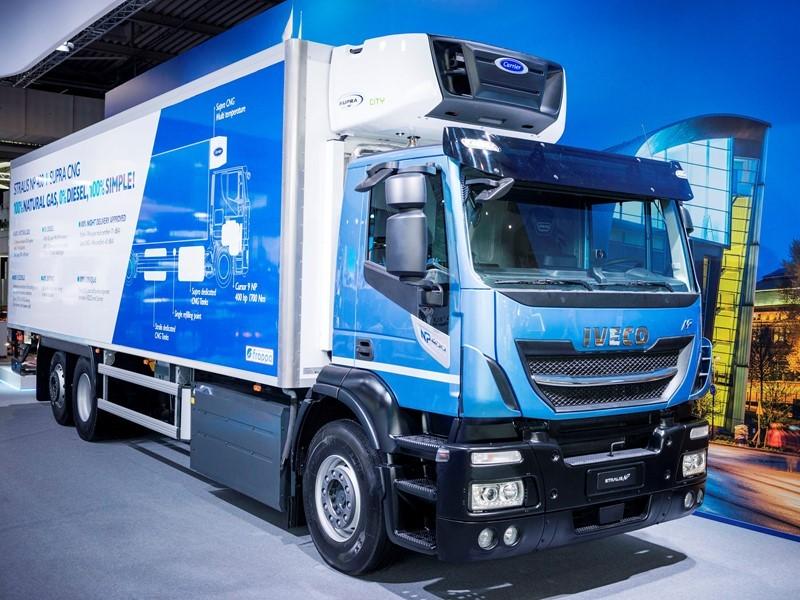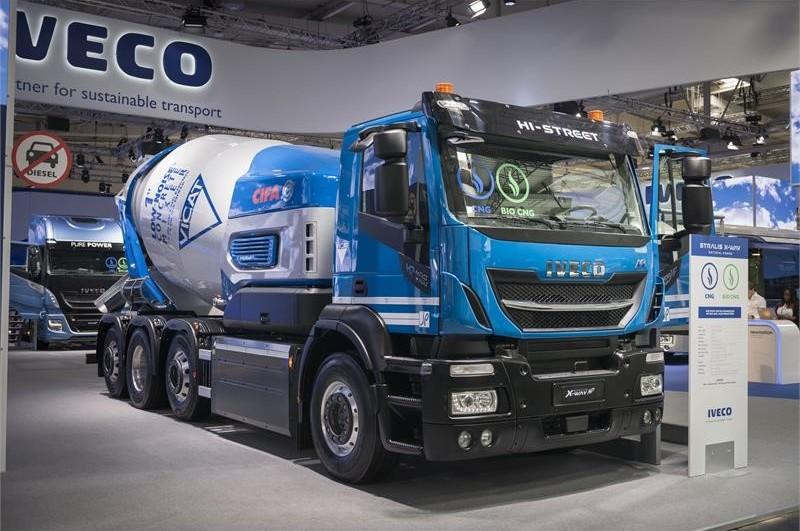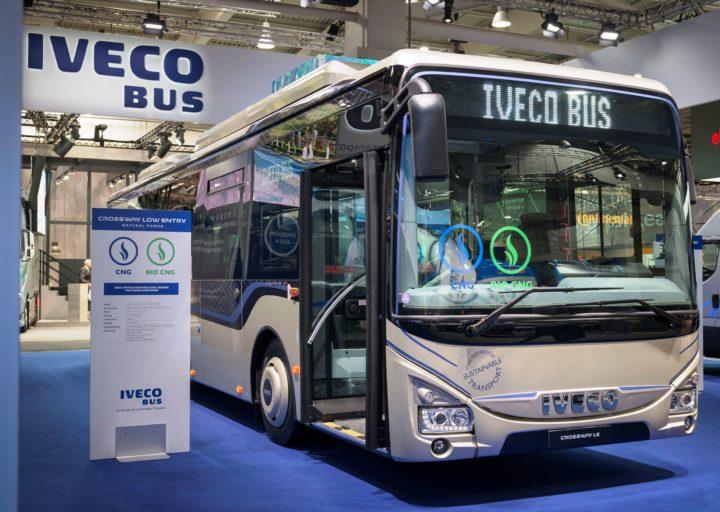
kscarbel2
Moderator-
Posts
18,550 -
Joined
-
Days Won
112
Content Type
Profiles
Forums
Gallery
Events
Blogs
BMT Wiki
Collections
Store
Everything posted by kscarbel2
-
Smartest and Most Productive Ford Transit Makes Global Debut at Hannover CV Show Ford Motor Company Press Release / September 18, 2018 New 2-tonne Transit improves productivity for businesses with fuel efficiency improved by up to 7 per cent and advanced new connectivity features Segment-first diesel mild hybrid (mHEV) powertrain option further improves fuel efficiency by up to 8 per cent in stop-start urban applications New powertrain offering includes upgraded 2.0-litre EcoBlue diesel with more powerful 185 PS variant, plus efficient new 10-speed automatic transmission for rear-wheel drive models On-sale from mid-2019, new Transit features smart new front-end design, all-new interior with enhanced stowage, and new driver assistance tech to make working days less stressful HANNOVER, Germany, Sept. 18, 2018 – Ford today revealed the new 2-tonne Transit model at the IAA Commercial Vehicle show in Hannover, Germany, marking the global debut of the smartest and most productive Transit ever. Providing increased load-carrying capability and upgraded powertrains that optimise fuel efficiency by up to 7 per cent, the new Transit also is introduced with a segment-first new diesel mild hybrid (mHEV) powertrain option that delivers an additional fuel efficiency improvement of around 3 per cent compared with the standard diesel model, with up to 8 per cent in stop-start urban applications. The new Transit is connected as never before, offering operators the benefits of the Ford PassConnect on-board modem technology which will help fleet professionals to improve vehicle utilisation and optimise running costs. On sale in Europe from mid-2019, the new Transit builds on the success of the outgoing model, which has helped to establish the Transit nameplate as the leader in its segment in both Europe and North America. Sales growth in Europe has continued during 2018 with 67,000 vehicles sold in August year-to-date, an increase of 14 per cent over the prior year. “This is a Ford Transit for the modern business world: it’s as tough and practical as our customers demand, cost of ownership is reduced and its connectivity will improve operational efficiency,” said Michael McDonagh, Transit global chief programme engineer, Ford of Europe. “Ford is also setting the pace in electrification, with a new mild hybrid powertrain ideal for urban deliveries.” Enhanced fuel efficiency. More choice Ford’s advanced 2.0-litre EcoBlue diesel engine* has been further optimised to deliver fuel efficiency improvements of up to 7 per cent according to Ford engineering data based on a real-world driving cycle. A fuel-injection system that increases peak pressure to 2,200 bar helps achieve more efficient combustion. To reduce friction within the engine, new steel pistons feature a slimmer skirt design than the out-going cast-aluminium design. A variable-flow oil pump reduces parasitic losses by adapting oil delivery to demand. Further fuel efficiency improvements are achieved with the introduction of electric power-assisted steering (EPAS) to the 2-tonne Transit for the first time; an extensive programme of weight saving; the use of low-rolling-resistance tyres; and aerodynamic enhancements. Fuel-saving Auto Start-Stop technology remains standard across the range. Drivers can also use Efficient Drive Mode, which uses GPS positioning to give predictive advice on how to achieve the best fuel economy on the road ahead. The choice of 105 PS, 130 PS and 170 PS power ratings is expanded with the addition of a new 185 PS variant, which delivers a generous 415 Nm of torque. All ratings benefit from an enhanced turbocharger design that helps to deliver a broader spread of torque across a wider speed range than before. From spring 2020, in addition to the standard six-speed manual gearbox, rear-wheel drive Transit models will be available with Ford’s highly efficient and responsive 10-speed automatic transmission featuring Adaptive Shift Scheduling, which assesses individual driving styles to optimise gearshift timings. Segment-first mHEV technology To provide even greater fuel efficiency benefits for commercial vehicle operators, the new Ford Transit introduces innovative diesel mHEV technology as an option for front-wheel-drive and rear-wheel-drive vehicles, which adds a further improvement of around 3 per cent based on WLTP analysis. Increased benefits of up to 8 per cent can be achieved in applications featuring a high proportion of stop-start driving, for example during urban delivery operations. A belt-driven integrated starter/generator replace the standard alternator, enabling recovery and storage of energy during vehicle decelerations, and charging a 48-volt lithium-ion air-cooled battery pack. The stored energy is used to provide torque assistance to the engine under normal driving and acceleration, as well as running the vehicle’s electrical ancillaries. The Transit mHEV system has been optimised to enhance fuel efficiency for operators rather than providing a performance boost over the standard powertrains. The immediate torque assistance provided by the hybrid system does, however, deliver improved response when pulling away at low engine speeds. Increased payload The new Ford Transit will be among the class leaders for payload, thanks to a programme of weight savings in every area of the vehicle, which has helped deliver increases in load carrying ability. To achieve these savings, the vehicle design was further optimised using advanced computer-aided engineering systems from the aerospace industry. Weight-saving examples include a new aluminium bonnet; the use of spun steel wheels with varied thicknesses; and a single exhaust muffler configuration replacing the outgoing twin-muffler design. For the first time, light, strong composite materials are used for the bulkhead in place of steel. A new Power Side Load Door also provides ease of operation when loading or unloading. The new high-mounted down-lighter offers excellent illumination when working at night in the area behind the rear cargo doors. Keeping connected As part of the strategy to expand connectivity across its entire commercial vehicle product line-up, Ford is offering FordPass Connect on-board modem technology for the new Transit, enabling fleet operators to improve vehicle utilisation and optimise running costs through solutions like the new Ford Telematics and Ford Data Services products that are also launching during 2019. The on-board modem also enables a range of features to be accessed via the FordPass mobile app to make the vehicle ownership and operating experience easier and more productive for owner-drivers and fleet drivers. Further advanced technologies include Ford’s SYNC 3 communications and entertainment system that can be operated using simple, voice commands, or via pinch and swipe gestures on an eight-inch touchscreen; and Ford’s MyKey system which allows fleet managers to program the key to limit driver’s speed and radio volume, and to permanently switch on active safety features. Aftermarket conversions and accessories can now access data from the Transit’s electrical systems via new Upfitter Interface Module. Driving business The Transit’s refined and car-like driving character is enhanced with the introduction of EPAS technology that also helps reduce driver fatigue by adding more assistance while parking and manoeuvring, and enables driver assistance technologies including Active Park Assist and Lane-Keeping Aid. For the first time, Transit drivers will be able to choose from Selectable Drive Modes to match driving performance to conditions: Eco Mode, Slippery Mode, Mud/Rut Mode for all-wheel drive models and Tow/Haul Mode for smooth power delivery when towing large trailers or boats that weigh more than the vehicle kerb weight. A comprehensive range of advanced driving assistance technologies have also been introduced to help reduce stress and tiredness, and to help avoid or mitigate the impact of collisions. These include: Blind Spot Information System with Trailer Tow system, featuring an extended blind spot zone that covers the vehicle plus a trailer of up to 10 metres in length Intelligent Adaptive Cruise Control, which combines the functionality of Traffic Sign Recognition and Adaptive Cruise Control to help drivers stay within legal speed limits Enhanced Lane-Keeping System Pre-Collision Assist with Pedestrian Detection, now capable of detecting pedestrians at night when they are illuminated by the headlamps New features are also provided to make life easier and less stressful when manoeuvring and parking within busy commercial and urban environments, and potentially avoid costly bumps and scrapes. These include: Front and Rear Wide-View Cameras to help drivers view oncoming traffic when edging out of a narrow parking space, on busy roads or when reversing High mounted rear-view camera, positioned to offer better visibility when reversing, in particular with the doors open Parking Aid, enhanced with additional side sensors Active Park Assist (APA), which helps drivers find suitable spaces and park handsfree nose-to-tail or side-by-side with other vehicles Park-Out Assist, which helps drivers exit parallel parking spaces hands-free Cross Traffic Alert warns drivers reversing out of a parking space of vehicles that may soon be crossing behind them. Instantly recognisable exterior. Practical all-new interior The Ford Transit’s smart new exterior features a taller, more assertive three-bar grille and a redesigned lower fascia. The front panels and bumper have been re-profiled to improve aerodynamics and create a bolder appearance with uncluttered easy-to-clean surfaces. High-series models feature powerful bi-xenon headlamps and new LED daytime running lights with a distinctive Transit family signature. In line with the latest Transit Custom, the vehicle has an all-new interior design, providing enhanced style, practicality and driver comfort. The new instrument panel is packed with practical touches for drivers who use the cabin as a mobile office, including significantly improved stowage with three open-topped bins on the top of the dashboard; a new device dock on lower series models enables drivers to mount both mobile phones and later larger tablets. The interior features attractive and hard-wearing materials, including smart new seat fabrics that have been subjected to Ford’s toughest ever abrasion tests. All-day comfort is further enhanced by new seat designs featuring revised foam padding and geometry for optimised support. A new Limited series is now available for the growing number of users requiring a high-specification variant to support their business requirements. As with the outgoing model, Transit customers can select from a huge range of more than 450 core variants, including front-wheel drive, rear-wheel drive and all-wheel drive drivelines, with a full range of bodystyles and chassis cabs, including the recently introduced low-height Skeletal chassis. The new Ford Transit will be produced at Kocaeli in Turkey alongside the Transit Custom; Ford last year announced a $52 million investment at the Ford Otosan joint venture in Turkey to expand production at the site by 40,000 units to 330,000 vehicles per year. * Officially homologated fuel-efficiency and CO2 emission figures will be published closer to on-sale date The declared Fuel/Energy Consumptions, CO2 emissions and electric range are measured according to the technical requirements and specifications of the European Regulations (EC) 715/2007 and (EC) 692/2008 as last amended. Fuel consumption and CO2 emissions are specified for a vehicle variant and not for a single car. The applied standard test procedure enables comparison between different vehicle types and different manufacturers. In addition to the fuel-efficiency of a car, driving behaviour as well as other non-technical factors play a role in determining a car's fuel/energy consumption, CO2 emissions and electric range. CO2 is the main greenhouse gas responsible for global warming. From 1 September 2017, certain new vehicles will be type-approved using the World Harmonised Light Vehicle Test Procedure (WLTP) according (EU) 2017/1151 as last amended, which is a new, more realistic test procedure for measuring fuel consumption and CO2 emissions. From 1 September 2018 the WLTP will fully replace the New European Drive Cycle (NEDC), which is the current test procedure. During NEDC Phase-out, WLTP fuel consumption and CO2 emissions are being correlated back to NEDC. There will be some variance to the previous fuel economy and emissions as some elements of the tests have altered i.e., the same car might have different fuel consumption and CO2 emissions. .
-
Ford – Europe’s top-selling commercial vehicle brand – to present new family of Transit products with built-in connectivity and advanced electrification at Hannover CV Show New 2-tonne Transit makes global debut, delivers enhanced fuel efficiency and payload, plus segment-first 48-volt mild hybrid (mHEV) technology Innovative Transit Custom plug-in hybrid (PHEV) van makes first appearance in final production form prior to 2019 launch Ford to showcase advanced Telematics and Data Services solutions for connected commercial vehicles to help fleet customers optimise efficiency and vehicle utilisation New Ranger Raptor – the toughest, highest performing version of Europe’s best-selling pick-up – storms into Hannover following public debut at Gamescom COLOGNE, Germany, Sept. 10, 2018 – Ford will reinforce its leadership of the European commercial vehicle market by presenting its latest generation of connected and electrified Transit products at the IAA Commercial Vehicle show in Hannover, Germany, from September 20-27, 2018. Ford is committed to deliver the benefits of connectivity across its commercial vehicle range in Europe. The company’s Hannover display will feature a comprehensive line-up of models that will feature on-board modems – led by the new 2-tonne Transit making its global debut at the Show – plus new Ford-developed products to help fleets optimise their operations. Ford’s innovation in commercial vehicles continues with its range of electrified products, including the Transit Custom plug-in hybrid (PHEV), making its show debut in production form, and the new Transit with a segment-first 48-volt mild hybrid (mHEV) powertrain. “Hannover will mark the arrival of an exciting new family of Transit commercial vehicles that are ‘born connected’,” said Hans Schep, general manager, Commercial Vehicles, Ford of Europe. “Advanced connectivity, and our game-changing electrified vehicles, will create extensive new opportunities to create value for our customers.” New Transit – higher productivity, mHEV efficiency The new 2-tonne Ford Transit will deliver more fuel efficient engines, increased payload, built-in connectivity and advanced driver technologies when it launches in mid-2019, along with a smart new front-end design and an all-new interior with enhanced stowage space. In addition to upgraded 2.0-litre EcoBlue diesel engines providing reduced cost of ownership, new Transit customers will be able to specify 48-volt mHEV technology on manual transmission vehicles to further improve fuel efficiency, particularly in stop-start urban driving. The mHEV system captures energy on deceleration in a 48-volt lithium-ion battery, and uses the stored energy to help drive the engine and electrical ancillaries. Transit Custom PHEV – zero emissions without range anxiety Ford’s innovative Transit Custom PHEV has an advanced hybrid system that targets a zero-emission range of up to 50 kilometres (31 miles), and features the multi-award winning 1.0litre EcoBoost petrol engine as a range extender. The EcoBoost engine charges the on-board batteries when longer trips are required between charging stops, providing operators with outstanding efficiency and flexibility, and a total range of more than 500 kilometres (310 miles). Displayed in final production form in Hannover, the PHEV has a compact liquid-cooled lithium-ion battery pack located under the load floor, preserving the full cargo volume offered by the standard van. The vehicle features the all-new interior design from the latest Transit Custom, including dedicated information displays for the PHEV variant. Ford Telematics and Ford Data Services – helping fleets to manage their vehicles Ford is announcing two new connected vehicle fleet solutions at Hannover, developed in-house by Ford Smart Mobility. These products have been created through a combination of powerful insights gathered from fleets of all sizes across many industries, and Ford’s in-depth knowledge and expertise of its vehicles and vehicle data. Ford Telematics will provide fleet operators with a web-based application providing solutions to help fleet professionals improve vehicle utilisation, maximise vehicle availability, optimise running cost and manage their drivers. Separately, Ford Data Services will enable fleet operators to have the option of working with their own third-party service providers to access OEM-grade vehicle data – delivered directly from the vehicle to the “cloud” – to create their own bespoke fleet solutions. New Ranger Raptor storms into Hannover Following a spectacular debut at the Gamescom trade fair in Cologne, the new Ranger Raptor makes its first appearance for an automotive audience in Hannover. Developed by Ford Performance for the true enthusiast off-roader, the pick-up will go on sale to thrill-seeking customers in Europe in mid-2019 powered by a Bi-turbo version of Ford’s 2.0litre EcoBlue diesel engine that delivers 213 PS and 500 Nm of torque. The commanding presence delivered by the ultimate Ranger’s imposing dimensions and extreme styling is supported by a unique Ford Performance chassis optimised for high-speed off-road driving and go-anywhere capability. * Officially homologated fuel-efficiency and CO2 emission figures will be published closer to on-sale date The declared Fuel/Energy Consumptions, CO2 emissions and electric range are measured according to the technical requirements and specifications of the European Regulations (EC) 715/2007 and (EC) 692/2008 as last amended. Fuel consumption and CO2 emissions are specified for a vehicle variant and not for a single car. The applied standard test procedure enables comparison between different vehicle types and different manufacturers. In addition to the fuel-efficiency of a car, driving behaviour as well as other non-technical factors play a role in determining a car's fuel/energy consumption, CO2emissions and electric range. CO2 is the main greenhouse gas responsible for global warming. From 1 September 2017, certain new vehicles will be type-approved using the World Harmonised Light Vehicle Test Procedure (WLTP) according (EU) 2017/1151 as last amended, which is a new, more realistic test procedure for measuring fuel consumption and CO2 emissions. From 1 September 2018 the WLTP will fully replace the New European Drive Cycle (NEDC), which is the current test procedure. During NEDC Phase-out, WLTP fuel consumption and CO2 emissions are being correlated back to NEDC. There will be some variance to the previous fuel economy and emissions as some elements of the tests have altered i.e., the same car might have different fuel consumption and CO2 emissions. About Ford Motor Company Ford Motor Company is a global company based in Dearborn, Michigan. The company designs, manufactures, markets and services a full line of Ford cars, trucks, SUVs, electrified vehicles and Lincoln luxury vehicles, provides financial services through Ford Motor Credit Company and is pursuing leadership positions in electrification, autonomous vehicles and mobility solutions. Ford employs approximately 201,000 people worldwide. For more information regarding Ford, its products and Ford Motor Credit Company, please visit www.corporate.ford.com. Ford of Europe is responsible for producing, selling and servicing Ford brand vehicles in 50 individual markets and employs approximately 54,000 employees at its wholly owned facilities and approximately 69,000 people when joint ventures and unconsolidated businesses are included. In addition to Ford Motor Credit Company, Ford Europe operations include Ford Customer Service Division and 24 manufacturing facilities (16 wholly owned or consolidated joint venture facilities and eight unconsolidated joint venture facilities). The first Ford cars were shipped to Europe in 1903 – the same year Ford Motor Company was founded. European production started in 1911. .
-
"At Ford Trucks, we’re serious about trucking"
-
-
Longtime Ford finance whiz Schloss to retire Michael Martinez, Automotive News / September 20, 2018 DETROIT -- Neil Schloss, who helped Ford Motor Co. avoid bankruptcy during the Great Recession and became CFO of the automaker's mobility arm, plans to retire at the end of December, Ford said Thursday. Schloss, 59, has spent 36 years at Ford and served in a number of financial roles, including a decade as treasurer. He most notably helped the automaker secure a $23 billion loan in 2006 by mortgaging most of its assets to help survive the economic downturn. Then in 2009, Schloss led a creative debt buyback plan that cleared $10.5 billion off Ford's books for $3.5 billion in cash and equity. In 2016, he became the founding CFO of Ford's mobility unit, which was created to explore and invest in mobility services, information technology and global data insight and analytics. Ford said it would name a successor at a later date. "For almost four decades, Neil has played an important role in driving our business forward," Ford CEO Jim Hackett said in a statement. "It was appropriate that he finish his career at Ford by helping to start the businesses that will be core to our future." Schloss reports to Marcy Klevorn, president of Ford Mobility. "Under Neil's leadership, we have been able to establish Ford Mobility as a robust business unit designed to create value for the company for years to come," Klevorn said in the statement. "We're fortunate that someone of Neil's global experience and deep knowledge was able to guide us through this important foundational stage of our company's transformation." Ford's mobility arm has invested heavily in self-driving vehicles and is exploring alternative modes of transportation, such as shuttle services and bicycle rentals. Schloss joined Ford in 1982 in the controller's office at Ford Aerospace, where he held a variety of positions. He joined Ford's treasurer's office in 1991. Since then, he has held a number of positions in funding, risk management, international financing, banking and trading with both Ford and Ford Credit. Schloss was appointed treasurer and elected a corporate officer in March 2007. .
-
Goodyear rolls out most fuel-efficient tire yet at IAA
kscarbel2 replied to kscarbel2's topic in Trucking News
Goodyear launches low emissions tyre Prime Mover Magazine / September 19, 2018 Global tyre manufacturer, Goodyear, has launched Fuelmax Performance this week at the IAA Commercial Vehicles 2018. Goodyear claims the new tyres are the most fuel-efficient in its range to date, as the first truck tyres to reportedly feature fill silica tread compound technology ensuring they meet full Three Peak Mountain Snow Flake (3PMSF) winter tyre requirements and achieve EU tyre label grade ‘A’ for fuel efficiency. In addition to Fuelmax Performance, Goodyear is showcasing new Proactive Solutions mobile phone applications to offer additional benefits to fleet managers and drivers as the company pursues for its customers reductions in emissions and total cost of ownership. The range features an RFID tag embedded inside each tyre that allows identification by external devices which link to tyre management systems for potential connectivity benefits. The New Mobility World features at the Goodyear exhibit. In a statement David Anckaert, Goodyear Commercial Tires Europe Vice President said tyres are crucial for sustainable mobility and are core components of vehicle performance. “The new Goodyear Fuelmax Performance tyres demonstrate our understanding of the challenges and opportunities that environmental objectives pose for our customers,” he said. “They further show our commitment to supporting OEMs and fleets in achieving those objectives and reducing costs.” The Fuelmax Performance tyres have been developed with low heat generation and low rolling resistance in anticipation of proposed EU legislation to reduce heavy vehicle Co2 emissions by 15 per cent in 2025 and 30 per cent by 2030. Goodyear claims a long-haul fleet of 100 vehicles using a Fuelmax Performance tyre combination can save up to 214,000 litres of diesel per year while reducing up to 557,000 kg of Co2. “Tyres are only part of the wider picture. Goodyear Proactive Solutions and other tyre-related services that we offer are key to optimising tyres’ full potential to further improve profits and reduce emissions.” . -
Diesel News Australia / September 19, 2018 The announcement of the winner of the International Truck of the Year has the prize awarded for the first time for a truck made outside of Europe. The new F-Max, produced by Ford Trucks in Turkey, has been elected International Truck of the Year for 2019 by a jury of 23 commercial vehicle editors and senior journalists, representing 23 major trucking magazines from throughout Europe. The prestigious award was handed over to Haydar Yenigün, Ford Otosan General Manager, during the press day of the IAA Commercial Vehicle Show in Hanover, Germany. With a winning score of 126 votes, the new F-Max heavy-duty prime mover fought off the challenges posed by Scania’s recently-launched L and P Series and the FH/FM truck range powered by liquefied natural gas (LNG) from Volvo Trucks. In terms of the International Truck of the Year (IToY) rules, the annual award is presented to the truck introduced into the market in the previous 12 months which has made the greatest contribution to road transport efficiency. Jury members take into account several important criteria including technological innovation, comfort, safety, drivability, fuel economy, environmental footprint and Total Cost of Ownership (TCO). During a recent extended test drive in Turkey, the IToY jury members praised the efficiency and advanced characteristics of the F-Max’s driveline, including Eco-Roll, Adaptive Cruise Control (ACC) and GPS-based Predictive Cruise Control functions. Equally impressive was the pairing, and quietness, of the in-line six-cylinder 12.7-litre Ford Ecotorq Euro 6 engine rated at 500hp in combination with the ZF 12-speed Traxon automated gearbox. The Truck of the Year journalists also appreciated the key features of the new long-haul cab, which offers a comfortable, ergonomic, user-friendly working and living environment, with a flat floor, a width of 2.5 m, an interior height of 2.16 m, excellent storage capacity and cockpit-style dashboard featuring a digital instrument cluster (which is both easy to read and navigate). Jury members also commented favourably on ConnecTruck, the connectivity platform of the vehicle. “With the introduction of F-Max, Ford Trucks has delivered a fine engineered truck that can be a meaningful new player in the highly competitive segment of long-haul transport,” said Gianenrico Griffini, International Truck of the Year Chairman in summing-up the jury vote. Also at the IAA event, a new annual Truck Innovation Award has been awarded by the International Truck of the Year organisation (IToY) for the first time. The award reflects the ongoing energy-transition taking place within the automotive industry towards new, unconventional, low-environmental footprint trucks. Entries for the Truck Innovation Award have been nominated and judged in parallel with the long-running International Truck of the Year award. The main criterion for the nomination and election of a truck for the Truck Innovation Award are based on its likely contribution to increasing the efficiency of transport of goods by road in the foreseeable future, as well as the potential reduction of its environmental footprint within the countries involved in the International Truck of the Year Organisation. MAN Truck and Bus has won the inaugural Truck Innovation Award for 2019 in recognition of its aFAS Level 4 automated driverless safety truck. The Truck Innovation Award was handed over to Joachim Drees, Chief Executive Officer of MAN Truck & Bus, during the press day at the IAA Commercial Vehicle Show. The aFAS, this acronym stands for ‘automated driverless safety vehicle for jobs on Federal motorways’ is a highly innovative safety solution developed by MAN over a period of four years, with the support of the German Ministry for Economic Affairs and Energy and with the involvement of technical institutions and several key component supplier-partners. With a winning score of 93 votes, MAN’s aFAS fought off competition from the Mercedes-Benz eActros, Volvo Trucks’ FL/FE electric trucks, Renault Trucks’ second-generation electric trucks, DAF’s Ecochamps and ZF’s Innovation Truck. During a recent exclusive press event in Linz , Austria, the IToY jury members were given an in-depth overview of the aFAS project. Furthermore, the jury had the opportunity to assess the Level 4 unmanned protective truck. The highly innovative vehicle, a MAN TGM 18.340, automatically follows another truck engaged in maintenance works on highways. .
-
Trump and Immigration (Illegal Immigrants in the US)
kscarbel2 replied to kscarbel2's topic in Odds and Ends
https://www.yahoo.com/news/exclusive-immigrant-children-detention-hhs-cuts-funds-programs-like-cancer-research-230259583.html Yahoo News / September 19, 2018 The Department of Health and Human Services is diverting millions of dollars in funding from a number of [U.S. citizen] programs, including the Centers for Disease Control and Prevention and the National Institutes of Health, to pay for housing for the growing population of detained [illegal] immigrant children. In a letter sent to Sen. Patty Murray, D.-Wash., and obtained by Yahoo News, HHS Secretary Alex Azar outlined his plan to reallocate up to $266 million in funding for the current fiscal year, which ends on Sept. 30, to the Unaccompanied Alien Children (UAC) program in the Office of Refugee Resettlement (ORR). Nearly $80 million of that money will come from other refugee support programs within ORR, which have seen their needs significantly diminished as the Trump administration makes drastic cuts to the annual refugee numbers. The rest is being taken from other programs, including $16.7 million from Head Start, $5.7 million from the Ryan White HIV/AIDS program and $13.3 million from the National Cancer Institute. Money is also being diverted from programs dedicated to mental and maternal health, women’s shelters and substance abuse. According to data from the Office of Refugee Resettlement obtained by Yahoo News, there were 13,312 immigrant children in federal custody as of Wednesday, Sept. 19, with ORR’s existing facilities at 92 percent capacity. The latest figures demonstrate the continued growth of this population just one week after the New York Times reported that the number of detained immigrant children in the U.S. has soared to record highs over the last year, from 2,400 children in May of 2017 to 12,800 earlier this month. Last week, HHS confirmed its plan to extend use of an emergency shelter in Tornillo, Texas, for the third time since it opened in June, and expand capacity at the “tent city” from 400 to 3,800 beds. The estimated cost of operating such emergency facilities is $750 per child per day — approximately three times the cost of a regular ORR shelter. “We support making sure ORR gets all the resources they need to help kids,” said Sen. Chris Van Hollen, D-Md., a member of the Senate Appropriations Committee and one of 19 Democratic senators who wrote Azar in July expressing concern over “a troubling pattern of chaotic, ideologically driven and opaque policymaking” in ORR’s unaccompanied child program. Van Hollen told Yahoo News Wednesday that the notification of the reallocation of funds to the Unaccompanied Alien Children program leaves key questions unanswered. Van Hollen said he was questioning “the reasons for need for additional money and how much of it is because you have more UACs coming across the border and how much is due to the Trump administration’s family separation policy?” He urged the Senate Subcommittee on Appropriations for Labor, Health and Human Services, Education and Related Agencies call Azar and other administration officials to a hearing on how the money would be used in the UAC program, and the impacts on the programs being cut. “The American public is entitled to facts behind the policies here,” he said. This is hardly the first time HHS has had to move money around to accommodate an influx of unaccompanied immigrant children in its care. But although the number of unaccompanied immigrant children apprehended along the border U.S. in fiscal year 2018 is on track to surpass that of the previous year, the rate is still well below those seen in 2014, when the flow of unaccompanied children across the border reached crisis-level proportions, or during the subsequent peak in 2016. And while the family separation policy has contributed to the demand for additional beds, the main reason is that children are spending more time in custody before they are released to a sponsor or returned home. -
Ford F-MAX named International Truck of the Year 2019
kscarbel2 replied to kscarbel2's topic in Trucking News
It's a massive accomplishment. Ford has not produced a global level heavy truck since the Transcontinental some 35 years ago. -
-
Alex Miedema Netherlands / September 19, 2018 The F-Vision is a pure electric concept truck from Ford Trucks. This is the prototype of a level 4 autonomous truck. The concept model reveals Ford Trucks’ future vision on electrification, autonomous and connected drive, lightweight and zero carbon emission products. It cares about humans’ priorities both inside the cab and on the road, as well as the load being carried, and aims constantly to connect with the environment and users and communicates. .
-
TTM Netherlands / September 19, 2018 The F-Max, the new long-distance truck from Ford Trucks, has been elected International Truck of the Year 2019. The award was presented Wednesday by ITOY jury chairman Gianenrico Griffini to Haydar Yenigün, general manager of Ford Otosan, on the press day of the trade show IAA in Hanover. The new F-Max, the name was secret until today, won with a point number of 126. With that, he beat the Scania Urban Range (74 points) and the Volvo FH LNG (56 points) amply. The rules of the International Truck of the Year award stipulate that the annual award is awarded to the truck that was introduced in the previous 12 months and that has made the largest contribution to efficiency in road transport. Jurly members consider various important criteria such as technical innovation, comfort, safety, handling, fuel consumption, eco-footprint and TCO. The ITOY election for 2019 was again under the auspices of the British branch organization Road Haulage Association (RHA). They gathered and checked the votes of the judges and determined the final result. The ITOY jury thanks RHA for its participation. The Truck of the Year jury was able to drive more extensively with the new Ford F-Max in his homeland Turkey. The judges praise the efficiency and the progressive characteristic of the F-Max powertrain. It includes Eco-Roll, Adaptive Cruise Control and GPS-based Predictive Cruise Control. Equally impressive is the six-cylinder 12.7-liter Ford Ecotorq Euro 6 engine, good for 500 hp, in combination with the ZF Traxon 12-speed AMT. The all-new cab was also appreciated by the Truck of the Year jury, composed of 23 of the best commercial vehicle journalists in Europe. The F-Max's cab is 2.5 wide and has a completely flat floor. Headroom is 2.16 meters, and there is more than enough storage space and the dashboard is located in a cockpit unit that is turned towards the driver. The display is largely digital and easily readable. Ford's self-developed connectivity platform ConnecTruck also scored well among the judges. Jury chairman Gianenrico Griffini expressed the jury's verdict: "" With the introduction of the F-Max, Ford Trucks has delivered a delicately designed tractor that is a sensible new player in the highly competitive segment of long-haul transport. " The International Truck of the Year Award has been in existence since 1977. The jury consists of 23 of the best European commercial vehicle journalists. On behalf of the Netherlands TTM.nl is chief editor Arjan Velthoven in the ITOY jury. The ITOY election for 2019 was again under the auspices of the British branch organization Road Haulage Association (RHA). They gathered and checked the votes of the judges and determined the final result. The ITOY jury thanks RHA for its participation. .
-
DAF: 90 years of innovative transport solutions
kscarbel2 replied to kscarbel2's topic in Trucking News
Some DAF trucks are produced in the UK at Paccar-owned Leyland. They are all branded DAF. https://www.bigmacktrucks.com/topic/53742-leyland-celebrates-20-years-with-paccar/?tab=comments#comment-401901 -
Scania Group Press Release / September 17, 2018 IAA Commercial Vehicles, the 67th trade fair of its kind, is scheduled be held at Deutsche Messe’s Hannover Fairgrounds in Germany from September 20-27. And Scania is ready to present a complete line-up of its next-generation trucks. This is no ordinary week for truck suppliers like Scania, or any other operator or in the commercial vehicle sector for that matter. The reason: September 20 marks the opening of the week-long IAA Commercial Vehicles motor show, a key trade fair that is held every two years with an expected 250,000 visitors. Ready to showcase a whole range of next-generation vehicles, Scania is likely to make its presence felt, not least with the attractive L-series plug-in hybrid truck for urban distribution. Housed in Hall 12, all of the vehicles that will be featured at Scania’s stand are run on alternative fuel. How better to demonstrate just how serious Scania is about leading the shift to sustainable transport? On the long-haulage front, the remarkably fuel-saving R-series tractor will be on display along with the V8 gem with the spacious S-series cab: already a favourite among drivers. Other highlights include: the 450 hp 8×4 from the versatile XT range, which is tailored for construction tasks; the L-series from Scania’s newly-launched urban range, with its unmatched visibility for challenging city traffic; the CrewCab fire truck; and a forestry truck. Meanwhile the full range of city, suburban and long-distance buses will be on show, as well as the Scania Interlink: the first long-distance coach run on liquified natural gas. .
-
The second generation of electric trucks is there !
kscarbel2 replied to kscarbel2's topic in Trucking News
. -
Renault Trucks Press Release / September 18, 2018 Ten years ago, we anticipated new needs for cities: more green spaces and electric mobility. Now we have made the future happen: cleaner and quieter with electric trucks. .
-
Scania Group Press Release / September 19, 2018 Don’t miss out on the news from Scania at this year’s IAA. Scania showcases the latest products and services due to help secure its lead in the ecosystem of mobility. A new generation of hybrid trucks and an industry-first coach with an LNG powertrain are among the vehicles on display: all sustainable solutions with powertrains designed to run on renewable fuels and make a difference to the climate. Besides this, a wide range of engines are on show, with alternatives available for almost any application. A new function has been introduced to the industry-leading cruise control system Scania AiCC Plus, which calculates the optimal distance between vehicles based on current road conditions. This takes us one step further towards true platooning. Scania Zone is an optional add-on in Scania’s Fleet Management suite. It allows each customer to link a policy (such as “Max speed 15 km/h”) to a pre-defined geofence zone so that when a vehicle enters the zone, it automatically complies with the regulations in place. A policy can be either informative, alerting the driver; or voluntary, which means that the vehicle’s behaviour changes but can be overridden by the driver. Added to this is the connected Scania C-me safety vest, which is designed to keep a protective hand over truck drivers. .
-
Commercial Motor / September 19, 2018 The Ford F-MAX was crowned International Truck of the Year 2019 (IToY) at the IAA Show in Hannover today (19 September). With 104 votes, the new Turkish-built truck beat Scania’s L- and P-series urban distribution trucks (74 points) and Volvo’s gas-powered FH (56 points) into second and third places. The jury, which consists of 23 commercial vehicle journalists from across Europe, was impressed with the newcomer, which features a flat floor, 500hp Ford Ecotorq engine and ZF TraXon gearbox. They praised the efficiency and advanced characteristics of its driveline, including eco-roll, adaptive cruise control and GPS-based predictive cruise control. IToY chairman Gianenrico Griffini said: “With the introduction of F-Max, Ford Trucks has delivered a fine engineered tractor that can be a meaningful new player in the highly competitive segment of long-haul transport.” These sentiments were echoed by UK jury member Will Shiers, who said: “While Ford’s previous Turkish-built trucks have been competent products suited to the domestic and nearby markets, the F-MAX is entirely different. It is capable of competing with the established players on the global stage with no allowances asked for or needed.” MAN Truck & Bus won the first IToY Truck Innovation Award in recognition for its eFAS level 4 automated driverless safety truck (left). The eFAS, which tows a safety sign and follows road crews on motorways, scored 93 points, and fought off competition from the Mercedes-Benz eActros (56 points), Renault Trucks’ second-generation Range D ZE Electric (45 points), ZF’s Innovation Truck (36 points), Volvo Trucks’ eFL and eFE (28 points) and DAF’s Ecochamps (25 points). Shiers said: “This truck has the ability to save lives, and is the first platoon I’ve seen that actually makes sense.” For the International Van of the Year, Peugeot, Citroën and Vauxhall were named the joint winners for their new small van. The Partner-Berlingo-Combo trio convincingly claimed the award with127 points, while second-placed Mercedes-Benz Sprinter scored 92 points. Third place was awarded to the Ford Transit Connect, which received 33 votes from the 25 jury members. The victory is the second IVoY win for Peugeot-Citroën’s light van, having previously won the award in 1997 for the first-generation van, as well as on three other occasions for its mid-sized and compact vans. Vauxhall-Opel too has tasted success in the competition for its Astravan and Vivaro, but this is the first victory for the newly united PSA Group. Judges praised the distinctive individual designs of the three vans, the comfortable and enjoyable driving experience, as well as new innovations for the sector, including the overload indicator. .
-
Ford Trucks introduces new F-MAX heavy tractor at IAA 2018
kscarbel2 replied to kscarbel2's topic in Trucking News
-
Ford Trucks introduces new F-MAX heavy tractor at IAA 2018
kscarbel2 replied to kscarbel2's topic in Trucking News
-
Ford Trucks introduces new F-MAX heavy tractor at IAA 2018
kscarbel2 replied to kscarbel2's topic in Trucking News
-
Ford Trucks introduces new F-MAX heavy tractor at IAA 2018
kscarbel2 posted a topic in Trucking News
-
Volvo Trucks Press Release / September 19, 2018 Volvo Trucks press conference at the IAA Commercial Vehicles Exhibition in Hannover, Germany, focused on the company’s 25th anniversary of the Volvo FH as well as connectivity, electromobility and automation. Claes Nilsson, President of Volvo Trucks, introduced Vera, Volvo’s future autonomous transport solution for the first time to a large gathering of transport and general media. .
-
Volvo Group Press Release / September 18, 2018 How do we build the cities and the infrastructure of tomorrow in a more sustainable way? Imagine a silent and emission free city. Imagine a cleaner safer and more resource efficient world. This is our scenario for the future. .
-
IVECO makes history at IAA 2018 with its Low Emission Area
kscarbel2 posted a topic in Trucking News
Iveco Trucks Press Release / September 18, 2018 100% Diesel Free stand and showcases a full offering of alternative Electric, CNG and LNG traction vehicles. On its 100% Diesel Free stand IVECO presents its solution to sustainable and zero emissions transport – available on the markets today - with its current commercial alternative powertrains offering and its long-term vision, in collaboration with customers, partners and bodybuilders. IVECO is displaying 18 vehicles showcasing its sustainable solutions that range from electric city buses to long-haul LNG trucks: a complete offering covering the requirements of every business and every mission that includes many award-winning vehicles, such as the Daily Blue Power ‘Van of the Year’ 2018, the Crealis In-Motion-Charging ‘Sustainable Bus of the Year’ 2019 and winner of the European Mobility Exhibition Innovation Award, the Crossway LE NP ‘Sustainable Bus of the Year’ 2018, and the Stralis NP 460 ‘Low Carbon Truck of the Year’’ 2018. IVECO is also celebrating the 40th Anniversary of the Daily, commemorating the vehicle’s long history of success with a Limited Edition personalised with a specially created design. IVECO is making history at the 67th edition of the IAA Commercial Vehicles (IAA), the most important international event in the commercial vehicle industry. It is showcasing its full commercial offering of alternative traction vehicles on a 100% Diesel Free indoor stand, creating a Low Emission Area at the exhibition. It is also hosting a dedicated Round Table focused on “The energy transition towards a sustainable future” and workshop events in collaboration with industry experts, customers and technical partners, to discuss the energy transition and related topics. Pierre Lahutte, IVECO Brand President, commented at the press conference held today on the stand: “IVECO is the first manufacturer in the history of the IAA to present a stand without a single Diesel Engine – neither on the vehicles or their bodies. The transport industry is changing, as the pressure on Diesel mounts and the energy transition gains momentum. Our display demonstrates that IVECO’s Electric, CNG and LNG offering is available today and offers a viable alternative to Diesel vehicles in all missions – from urban high-value, low energy intensity people transport to long-distance heavy-duty haulage. In addition, natural gas offers the possibility for a seamless transition to biomethane and renewable energy, achieving zero emissions and opening the door to a circular economy approach that can go so far as achieving negative emissions and carbon sequestration.” Also present on the stand, and speaking at the press conference, is global energy supplier Shell, which shares IVECO’s belief that de-carbonisation of the transport sector requires a range of fuels and technologies. As part of their collaboration with the brand to promote the development of the electric and natural gas refuelling networks in Germany, Shell is also displaying on the stand a CNG/LNG filling station and an electric charging station. IVECO’s display at the IAA 2018 shows its solution to sustainable transport, with an energy mix that matches the requirements of the different missions. It sees electric propulsion as having an important role to play, especially in high-value missions such as people transport – particularly in low speed, low energy intensity stop-and-go missions in city centres. The other key energy source is natural gas, which provides a mature solution for sustainable transport of people and goods. Through its display and workshops, IVECO is highlighting the considerable environmental advantage of natural gas, which is able to deliver massive reductions in the most polluting emissions: 90% for NO2, 99% for particulate matter, 10% for CO2 with natural gas which rises as high as 95% with biomethane well to wheel. A circular economy based on the generation of energy from organic or agricultural waste is possible with biomethane. This can be done at an organic waste treatment centre, which generates natural gas and fertiliser from door-to-door collection, green waste, institutional catering and municipal waste. This approach can be taken even further, when methane is generated in a biodigester on a farm, using crops and agricultural waste. As they grow, the crops absorb CO2 and convert it into carbohydrates, fixing the Carbon and releasing Oxygen into the atmosphere. In the farm’s biodigester, the crop residues decompose through an anaerobic digestion process, producing biogas. This is purified into biomethane, which can be transported to filling stations and used to fuel natural gas powered vehicles for goods transport. This process also produces a nutrient-rich substance that is used as a fertiliser compost, returning nutrients to the land, increasing its organic matter content and sequestering carbon from the atmosphere. As a result, this circular economy approach goes beyond reducing CO2 emissions well to wheel, as it fixes carbon in the ground, reducing CO2 in the air and making the cycle carbon negative. Visitors to the IVECO stand will be able to see that this circular economy is already a reality, with the examples of the city of Lille, which operates a fleet of IVECO CNG buses fuelled with biomethane generated from municipal waste; the project led by Pot au Pin, Air Liquide and Carrefour based on biomethane from agricultural waste; and the opening of the world’s largest biogas plant in Norway by Biokraft. Through its presence at the exhibition, IVECO aims to promote the use of sustainable technologies. In addition to the vehicle display itself and the various events it is hosting, it has dedicated an Educational Area on the stand to informative panels and videos on four key themes: ‘Gas and biogas - the sustainable transport solution today and tomorrow’; ‘Our contribution to CO2 reduction’; ‘Sustainable solutions for fleet management’ in collaboration with technological partner Michelin; and TCO, efficiency and productivity’. IVECO at IAA: a 100% Diesel Free stand with 18 vehicles to showcase a complete sustainable offering covering every business and every mission The 100% Diesel Free stand, with its display, highlights IVECO’s approach to sustainable transport, which matches the technology and energy source to the requirements of the mission. For city centre public transport, the stand showcases the brand’s electric solutions: the zero-emissions Daily Electric Minibus, part of the Daily Blue Power sustainable family that was crowned “International Van of the Year 2018”, which offers the perfect solution for transport in the typical last mile, stop-and-go city centre missions; the Heuliez Bus GX ELEC fully electric city bus featuring the most advanced battery technology; and the new generation of IVECO BUS Crealis In-Motion-Charging, which combines the electric overhead lines with on-board battery energy storage and in-motion charging, and won the Sustainable Bus of the Year 2019 title in the Urban category and the Innovation Award in the Move Green Energy-Environment category at the European 2018 Mobility Exhibition in Paris. For suburban public transport, CNG is the solution on display, with the IVECO BUSCrossway Low Entry Natural Power, Sustainable Bus of the Year 2018, which stands out for its design with the tanks integrated into the roof space and autonomy up to 600 km. For urban and suburban goods transport, IVECO is showing different models of Daily Natural Power, also part of the Daily Blue Power family – four of them featuring the class-exclusive Hi-Matic transmission. The Daily Hi-Matic Natural Power is the first Light Commercial Vehicle equipped with a 3.0 litre CNG engine with an 8-speed automatic gearbox in the industry. The models on display showcase the wide variety of missions the Daily Blue Power family can cover with its extensive offering: a chassis cab equipped with a Lecapitaine refrigerated box for the rental fleet of Le Petit Forestier, the European leader in refrigeration rental; a 7 tonne chassis cab equipped with a Junge platform and curtainsider; a chassis cab equipped by Fassi with a Maxicargo tipper trailer and crane for Ville de Paris; a van equipped with a Kerstner deep cooling fridge in the 40th Anniversary Limited Edition livery and a van equipped for parcel deliveries by Spier with a personalisation designed by Garage Italia Custom to commemorate the Daily’s anniversary. For urban and regional transport missions, CNG is the technology that meets the combine requirements of efficient transport across longer distances and deliveries in city centres. IVECO is showcasing two Eurocargo focused on municipal applications, both in CNG version and already compliant with EURO VI Step D emissions standards, one year ahead of time. One of the models on display is equipped with a 3-way tipper by Meiller. The second model on display is the result of IVECO’s collaboration with a technological partner to address the emissions of both truck and body: it is equipped with a sweeper body developed by Johnston Engineering that combines the truck’s CNG engine with a hydrostatic transmission, achieving a dramatic reduction in emissions compared to a traditional truck-mounted sweeper, which usually adds a second diesel engine, which is less regulated or even unregulated, to run the sweeping equipment. IVECO also partnered with Carrier Transicold for an industry first: the brand new 26-tonne 400 hp Stralis NP rigid equipped with a Frappa body and featuring Carrier Supra® CNG technology. This groundbreaking solution is a 100% Natural Gas, 0 % Diesel, 100% Simple truck with refrigerated body. Contrary to standard trucks for temperature-controlled goods transport, which have two diesel engines - one to power the truck and one to run the cooling group compressor which is far less regulated - this Stralis NP only uses Compressed Natural Gas (CNG). Both the vehicle and the cooling group run on Stoichiometric natural gas engines equipped with 3-way catalysts. This results in ultra-low NO2 (-90% compared to diesel) and Particulate Matter (-99%) emissions that are well below regulations limits. For CO2 emissions, the reduction is as much as 95% with biomethane. For long-distance missions, IVECO’s solution is LNG technology. In this sector, it leads the way with the Stralis NP, the first natural gas truck specifically designed for long-haul transport on the market, and in particular with the Stralis NP 460, which last December was elected Low Carbon Truck of the Year in the UK. IVECO is showcasing this offering with models in articulated and rigid versions, including AD and low tractor trucks. Also in this sector, IVECO is presenting another industry first resulting from an important partnership: the unique 400 hp Stralis X-Way Natural Power equipped with a CIFA electric concrete mixer that offers a 100% zero Diesel, zero oil solution. The truck runs on bioCNG and is equipped with the Energya hybrid plug-in concrete mixer developed by CIFA. The mixer is operated by an electric engine powered by a lithium battery. It also features a Kinetic Energy Recovery System that recovers the truck’s energy when it is decelerating. The other Stralis NP models on the stand include the first 460 hp LNG truck for swap body missions equipped by SDG / Spier for Fraikin’s rental fleet; the first 6x2 LNG tractor with 750 km autonomy, a 4x2 LNG tractor with 1,600 km autonomy, and a low tractor in LNG version with 1,150 km autonomy. All the vehicles on display in the 100% Diesel Free - Low Emissions Area are a tangible demonstration that IVECO and its partners are delivering on the promise to deliver sustainable transport and solutions. .
BigMackTrucks.com
BigMackTrucks.com is a support forum for antique, classic and modern Mack Trucks! The forum is owned and maintained by Watt's Truck Center, Inc. an independent, full service Mack dealer. The forums are not affiliated with Mack Trucks, Inc.
Our Vendors and Advertisers
Thank you for your support!

